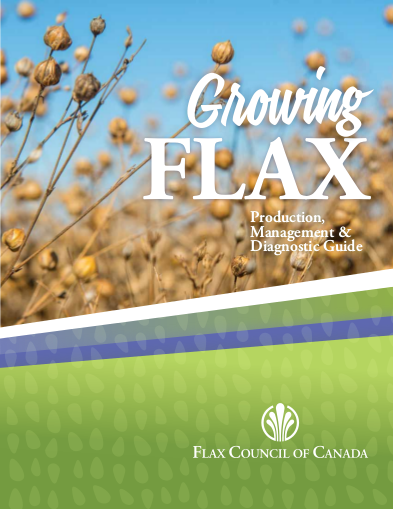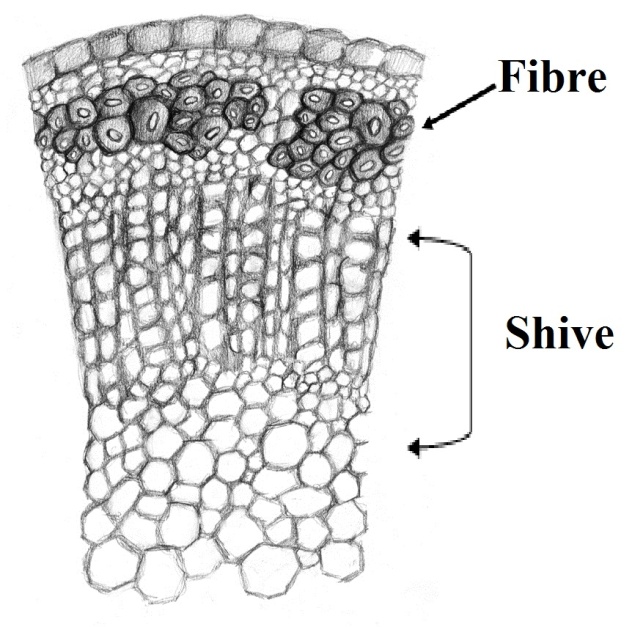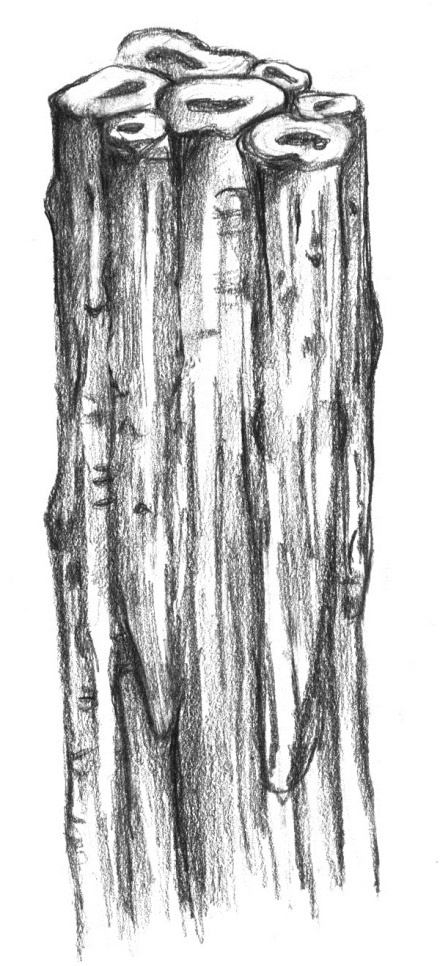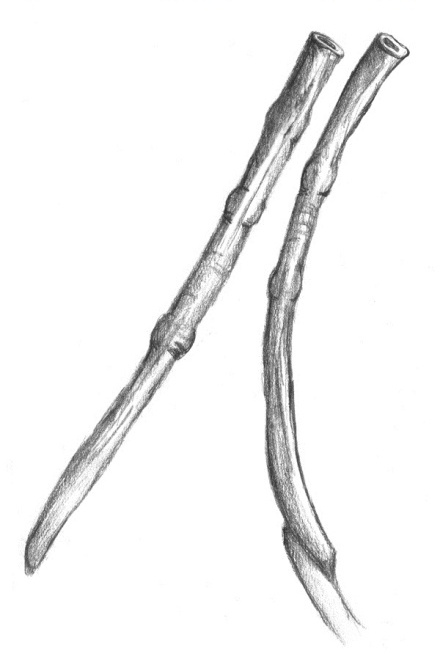Chapter 12: Flax Straw and Fibre
Past and Present Uses
Chapter 12 – PDF version
Download the PDF version of ‘Chapter 12: Flax Straw and Fibre’.
Growing flax can present “the straw problem.” Oilseed flax has a significant percentage of long tough stem fibres that decay slowly over time. This makes it difficult to incorporate flax straw into the soil after harvest since the fibres wrap themselves around and/or plug disks, wheels and seeder-shanks. In the past, the only way to cope with flax straw was to drop it in windrows after the combine and then burn it directly or harrow or rake it into piles and then burn it. More recently, straw choppers on new combines have been used to effectively chop and spread flax straw, if the straw was dry and relatively short or fibre content was relatively low due to drier growing season weather.
At the present time, there is one major commercial buyer and processor of Prairie flax straw, Schweitzer-Mauduit Canada, based in Winkler, MB. It extracts flax fibre for use in the production of paper for cigarettes and some plastic composite products. Schweitzer-Mauduit Canada also extracts shive (the non-fibre part of the stem) for bio-fuel, animal bedding and mulch. There are several much smaller buyers and processors. These include, but are not limited to, Biolin Processing based near Elstow, SK (50 km southeast of Saskatoon), a pilot processing facility operated by Alberta Innovates Technology Futures in Vegreville, AB, Synermulch in Calgary, AB, Erosion Control Blanket in Riverton, MB, and Urban Forest Recyclers Inc. in Swift Current, SK. There are also several hemp and biofuel processing facilities that, from time to time, buy flax straw to supplement their sources of raw materials.
Existing and potential processors prefer tall, weed-free, contamination-free (i.e., no litter or items made with plastic) flax crops situated within 100 km of a processing plant or a processor’s bale stack yard. In the past, Schweitzer-Mauduit Canada normally paid $5 to $10 per tonne for the straw, depending on the year and whether or not the straw could be baled in the spring. In addition, they usually arranged and paid for the baling, transport and storage of the straw.
Depending on the acreage planted and rainfall, the potential salvageable oilseed flax straw on the Prairies is 500,000 to 1,000,000 tonnes annually. The fibre content of oilseed flax straw usually ranges from 15 to 25%. As such, the annual potential pure fibre production from flax presently grown on the Prairies would be between 75,000 and 250,000 tonnes. Schweitzer-Mauduit Canada processes from 80,000 to 120,000 tonnes of straw annually. The vast majority of the presently extracted flax fibre is exported as 60–80% pure fibre. The total value of such flax fibre exports ranges from $8 to $18 million annually (i.e., 2 to 8% of the total value of flax seed exports). Emerging flax processors who are targeting more valuable markets for fibre and shive may be able to pay significantly more for good quality straw ($20–$80/tonne); however, it will take time before the volumes rise to significant levels.
Market News
Linoleum is widely recognized and recommended by architects and interior designers globally.
Reducing the Straw Problem
Managing flax straw may be mitigated by a number of agronomic and equipment tips, including:
- Seed reasonably early. This generally results in shorter plants and will allow for earlier harvest under warmer, drier conditions;
- Combine flax on hot, dry days. This will make it easier to chop and spread since cellulose-based fibres lose strength as they get drier;
- Use a rotary combine with high rotor speed and tight concave settings. This will make it easier to chop and spread because the turbine is doing more of the work in breaking up the straw. Seed damage may be a concern under these operating conditions;
- Buy and use after-market straw choppers that may be more effective for a given amount of engine power. This will make it easier to chop and spread the straw and easier to seed into the flax stubble next spring;
- Use new hammers and sharp blades in an existing chopper and/or use one configured for ‘fine cutting”. This will also make it easier to chop and spread the straw and make it easier to seed into the flax stubble next spring.
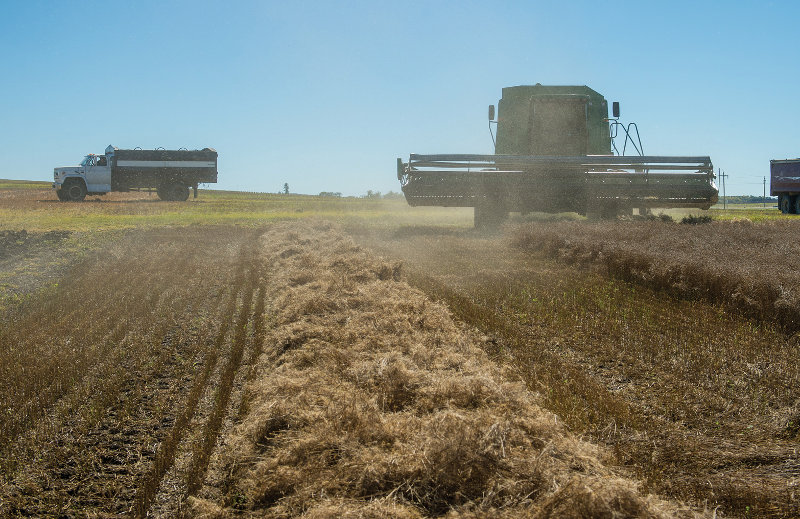
Market News
Flax allows for a variety of marketing choices at any time of the year.
Enhancing Possible Income from Flax Straw
Aside from the above conditions and methods, the other major way to deal with “the straw problem” is to find ways to use and/or sell the straw. There are several possible approaches to enhance possible income from flax straw. One approach is to try and find buyers for the flax straw that presently comes out of a combine. Such buyers are not plentiful and generally do not pay very much, but they do exist. The following list may help growers find local outlets for their straw.
- Animal bedding–especially for dry cows living outside during winter;
- Cattle feed–has the feeding value of slough hay so it is really only as a reserve feed when better feed sources are hard to get;
- Duck nesting sites–Ducks Unlimited and some local hunting groups buy flax bales and pull them on the ice of shallow sloughs during winter. In spring the bales partially sink, but still provide safe little island nesting sites;
- Linings for drainage ditches and road embankments–i.e., local governments often buy flax bales to limit the eroding forces of fast running spring melt water, heavy rains and/or wave action from large sloughs that come up to and/or over the edge of roads;
- Ground firming–feedlots and oil well drilling companies sometimes buy flax straw and have it spread to firm up muddy alleyways and well drilling sites;
- Shelter belt mulch–loose straw can be shredded and blown over young shelter belt trees to conserve soil moisture and reduce weed growth;
- Straw bale buildings–non-traditional builders of houses, shops, garages, etc. often use small square flax bales for wall construction;
- Wind breaks and shelters–round bales are stacked on end, with or without a narrow space between, to cut the wind for cattle and/or to hold back snow from roads or yards;
- Bale burners–some people have built burners that can use large round bales to heat water that is then piped underground to heat homes, barns, shops, greenhouses and other buildings;
- Golf course green covers–some golf courses buy and shred bales of flax straw over their greens to protect from winter kill;
- Nursery plant insulation -some nurseries cover their perennials or tipped over container trees with a thick layer of flax straw in the fall to protect plants from cold air temperatures. In the spring, the straw is taken off and container trees are tipped upright again;
- Insulation–some greenhouse and trailer home owners put small flax bales on the ground next to their buildings to reduce heat losses over the winter; and
- Garden and orchard pathways -some owners spread flax straw in their pathways so staff and customers do not have to walk on muddy ground during rainy weather.
The second approach to possibly getting income from flax straw is to work with existing or potential processors to find ways to improve the quantity and/or quality of flax straw and/or of the fibre in the straw. The following are some conditions and practices that should help achieve this:
- Warm weather with adequate rainfall from shooting to maturation stages;
- Moderate levels of nitrogen fertilizer and balance of other nutrients needed for a realistic target yield based on soil test recommendations;
- Do not use a desiccant unless deliberating trying to produce immature fibre with thinner, more flexible and usually higher value fibres;
- Higher seeding rates combined with a narrower space between rows (tends to produce finer stems with higher fibre content. This also results in better weed competition and faster retting);
- Practice good weed control including consideration of a soil residual herbicide like Authority®;
- Use a fungicide like Headline ® to reduce plant stress from pasmo and/or to prevent premature senescence. This increases the duration of fibre formation;
- Combine flax on days when heat and/or dryness are not excessive;
- Use a conventional or rotary combine with cylinder or rotor speeds and concave settings at the minimum settings required for good threshing;
- Consult with potential end users to see if straw length and retting is important and/or valuable to them.
In some cases, processors will accept straw that has dropped out of the back of a combine but has not been through a chopper. In some situations, where straw is relatively tall, the end user may want the grower to use a stripper header or to straight cut as high as possible, to preserve the length of the straw and minimize the amount of straw going through the combine. The straw chopper would be still be used to chop and spread seed boll stalks and chaff. The standing straw would then be cut down at ground level in a way that leaves a thin even layer of straw covering the surface of the field. This could then be left to ret (by late fall or early spring). The retted straw would then be raked into rows and baled.
In some locations, tall straw left standing over winter will “weather” enough by spring that it will take on attributes similar to retted straw, however, the actual amount and type of weathering that takes place varies considerably with the type and duration of weather events that occur in a given winter (i.e., how much snow, how many freezing and thawing cycles, etc.)
The value of such straw to the farmer could vary from $20/tonne to $80/tonne, depending on the quality and quantity of the straw, processor end products and the proximity to the processing plant. Yields of straw could vary from 0.75 tonnes to 5.0 tonnes/ha (0.3 to 2.0 tonnes/acre) depending on growing season weather, agronomic practices, harvesting and post‐harvest methods.
Potential Future Developments
Alternative and new uses
Several developments are changing flax straw from a “burning issue” into a “growing
opportunity.” It is even feasible that, in the future, some growers will grow fibre flax (i.e., linen flax) instead of oilseed flax and receive the majority of their income from straw and not from seed. However, management and technical requirements will have to develop to optimize fibre value. Planting and processing costs will also have to significantly decrease if higher net incomes from flax straw are to be realized and if rural communities want more value-added processing of flax straw. The following paragraphs describe these opportunities, going from lowest value to highest value.
Whole flax straw
Bio-fuel–In certain circumstances, it can be profitable for farmers or a large user of fuel (i.e., large barn or greenhouse) to collect their own or neighbors’ flax straw or shives and burn it in large scale burners. However, if the bales or shives have to be hauled a significant distance, the transport costs may overtake cost savings of using straw. Similarly, the transport costs for fuel pellets and logs made from flax straw or shives to major user markets (i.e., Europe) may quickly eliminate the profit potential. In addition, in Western Canada, coal and natural gas are alternative fuels, so in most cases, there is little financial incentive for large Western Canadian users of heat to consider burning flax straw or shive.
Flax fibre
Pulp sweetners–The addition of extra strong fibre into a pulp mix is referred to as a “pulp sweetener.” Since flax fibres are considerably stronger and longer than virgin wood fibres, a smaller amount of flax fibre can be used to replace virgin wood fibre used to strengthen recycled paper in pulp. This increases the percentage of recycled paper that can be used in the pulp. As recycled paper and tree-free paper become more popular, the use of flax fibre as a pulp sweetener is expected to increase.
Geotextiles and ground stabilization–Increasingly, road, railroad, mining operations and building sites require a mesh of fibre to reduce dust and erosion produced during construction and on-going operations. A mesh of fibre can be blown on (i.e., hydro mulching) or rolled out in a thick blanket-like material, called a geotextile. The use of flax fibres for geotextiles and ground stabilization is expected to increase, especially in areas where the end user is situated relatively close to flax-growing regions.
Insulation–In Western Europe, there are more than six companies producing flax-based insulation to compete with fibreglass. In Europe, the demand for flax fibre-based insulation is growing by more than 40% annually. The driving force behind this growing demand is due to:
- The continued drop in the price premium for flax fibre insulation;
- It is not itchy like fibreglass insulation;
- Flax fibre insulation can be easily decomposed when its useful life is over;
- Fibreglass will end up in a landfill; and
- Flax fibres would be less harmful than fibreglass if inhaled during handling.
Plastic composites–Many everyday plastic products (i.e., car dash boards, sewer pipes) contain fibreglass to provide strength, reduce weight and/or reduce cost. Researchers have found that, in many plastic composite applications, flax fibres can replace fibreglass. Flax fibres are generally cheaper, lighter in weight, less abrasive and impart more springiness than fibreglass. In addition, flax fibres require less energy to manufacture and are easier to decompose or burn, than fibreglass.
The demand for flax fibres in plastic composites is growing by more than 50% annually in Europe and this trend has now started in North America. The largest users are automotive parts manufacturers, who are being pressured to make cheaper, lighter weight vehicles with lower gas consumption. There is also consumer pressure to use more environmentally friendly materials in the manufacturing process. This trend is spreading to other transport related industries (i.e., buses, trains, trucks, RVs, planes) for similar reasons. Some of this research is being conducted at the Composites Innovation Centre in Winnipeg, Manitoba.
Cottonized flax–The demand for cotton worldwide in 2014 was roughly 28 million tonnes and is growing by about 200,000 tonnes annually. Physically, the fibres in stems of flax are actually bundles of tiny fibres called “ultimate fibres”. These ultimate fibres are roughly half to one-third the diameter of a human hair and, as such, are similar to the diameter and length of cotton fibres. Flax fibres absorb about 50% more moisture than cotton fibres. Hence, garments made from flax fibres will feel cooler and drier than cotton garments, especially on hot, humid days. Over 90% of the world’s spinning and weaving equipment is designed to use fibres with the approximate length and diameter of cotton fibres. Researchers are looking at low cost ways to produce ‘cottonized’ flax. These methods include the use of specialized carding machines, enzymes, flash hydrolysis (steam explosion), high voltage jolting in water and ultra-sound in water. Breakthroughs have been made in all these methods and costs are rapidly falling to the point where cottonized flax could beblended much more extensively with cotton fibre to produce cooler, cost effective fabrics.
Long line flax for pure linen
Flax fibres have been used for over 5,000 years to produce yarn that can be woven into cloth and garments. The yarn and fabric made from flax fibres are called linen. Only in the last century in North America, has linen also come to mean fabric-based items used on tables and beds. In modern times, the fibres used to produce pure linen yarns are 50 to 100 cm (19.7 to 39.4 in.) in length, are easy to divide into finer fibres, yet are strong enough to be spun and woven without breakage. Such fibres must also be clean of all non-fibre components. These requirements cannot normally be met unless flax straw is retted. In addition to retting, most flax fibre crops are pulled out of the ground with special machines when the plants are still partially green and stems are laid on the ground in thin aligned layers. This allows for a higher yield of long, clean fibres that are finer in diameter and ret faster and more uniformly.
Traditionally, pure linen yarn was uneven and could only be woven. This produced a fabric that was comfortable and long lasting, but wrinkled easily. In the last decade, spinners have finally found ways to make linen yarn even enough so that it can be knitted. This has allowed the production of linen garments that resist wrinkling. In addition, researchers have developed several chemicals that can be used to treat linen fabrics so they are wrinkle-resistant.
These developments have increased the demand for flax straw used for the production of pure linen yarn. With this opportunity, the net revenues generated by the grower producing fibre flax varieties are much higher than the returns expected when oilseed flax is grown. However, the management and capital requirements are also much higher.
Flax shives
When flax fibres are extracted from flax straw, the non-fibre parts of the stem, not including the seed, are normally referred to as shives. In oilseed flax, shives comprise between 70 to 85% of total straw weight. Thus shives are a major by-product of flax straw processing. Finding profitable end-uses for shives is an important consideration to ensuring the financial viability of a flax straw processing plant. In Europe and Asia, flax shives are often used to make particleboard. In North America, wood particles are generally so cheap that this is not a viable commercial use at this time. Currently, flax shives are often burnt as fuel or used as horticultural mulch. They are also increasingly used as horse, livestock and pet bedding. They can also be ground and used as a filler to reduce the weight and cost of certain plastic items.
Processors’ requirements
It is expected that there will be a significant expansion in the size and number of firms processing flax straw on the Prairies. It is likely that at least some processors will pay significantly more for flax straw than what has been paid in the past. Quality standards for straw will be developed so processors can start selling flax fibres into higher value fibre markets. In such markets, flax fibres would compete with glass, cotton and synthetic fibres which have measurable and generally quite consistent properties. If flax fibres are to effectively compete in such markets, growers and processors must be able to produce straw and fibre with consistent quality and easily measured properties.
These properties include but are not limited to the cleanliness, length, fineness, strength and consistency of the fibres. The shives would be inspected for cleanliness, dust content, particle size and consistency. The straw would be evaluated for cleanliness, height, fibre content, degree of retting, average diameter and consistency. Ultimately, both growers and processors must be able to quickly identify straw, fibre and shive samples that are superior; must know how to influence various characteristics; and must receive sufficient financial incentives to produce the characteristics end users demand.
FIBRE GROWTH AND DEVELOPMENT
Like all plants, flax goes through sequential stages of growth and development (Chapter 4: Growth and Development). The following stages and timing of these stages are generalizations but will provide insight into various aspects of flax fibre content and quality. In the first 30 days after planting, the seed germinates, starts developing roots and produces a shoot a few inches high. Fibre cells start developing where the first true leaves emerge out of the stem. As such, there are no stem fibres in the stem from 2 to 5 cm (3/4″ to 2″) above the ground. Fibre cells are modified phloem cells and are found in a layer just beneath the waxy cuticle surface of the stem. When they form, they grow into tiny hollow tubes 3.7 to 5.0 cm (1.5″ to 2″) long with tapered pinched off ends and look microscopically much like drinking straws with pinched ends. (See Figures 12-1, 12-2, 12-3, and 12-4 for drawings of a flax stem, fibre bundles and ultimate fibres).
From 50 to 60 days after planting, the flax plant elongates and daily grows 1 to 3 cm and produces 2 to 4 new leaves. Each leaf is associated with one or more fibre cells. During this stage, the maximum number of fibre cells is determined and the fibre cells are often even finer in diameter than cotton fibre. The stem extension growth stage is followed by the flowering stage which lasts 15–25 days. Once flowering begins, flax plants seldom produce new fibres. When flowering is finished, the plant matures during the next 30 to 40 days and concentric layers of cellulose are deposited inside the hollow fibre cells, in a manner similar to hard water mineral build up inside copper plumbing pipes. These layers of cellulose can make the fibre cells much heavier, more solid and expand their girth as they push into neighboring fibre cells. Then, the flax plant starts drying down and turns from green to yellow to beige.
As the flax plant matures, slippery, sticky pectin between the fattening fibre cells dries up and forms glue. This glues groups of fibre cells together to form a “bundle” of fibres which looks like a thread several times thicker than a human hair. To isolate a single “ultimate” fibre from a flax plant the dried up pectin and lignin must be removed. This pectin and lignin holds the fibre bundles to the rest of the plant and/or holds the fibres to one another within the bundle. Over the centuries, the most popular method to achieve fibre separation was to create conditions that allow microbe’s sufficient time to grow on flax straw and dissolve the pectin that is gluing the fibres and fibre bundles together. However, it is important that the microbes are not active for too long as they would start dissolving the cellulose in the fibres and weaken the fibres). This process is called retting (see Figures 12-5 and 12-6) and can be done in fields (field retting) or in water (i.e., water retting, river retting, tank retting, bog retting). After retting an optimal amount, the straw is dried and mechanical or manual methods are used to extract the fibres.
Growing season weather, agronomic practices and plant genetics (varieties) greatly affect the quantity and quality of fibre in a flax plant. Fibre quantity and quality depend on the interaction between genetics and environmental conditions during the life cycle of the flax plant. For instance, after a very dry hot summer on the Prairies, fibre content in standing unretted oilseed flax has been as low as 5%. Conversely after moist warm summers, fibre content in oilseed flax has been as high as 27%. For most years, oilseed flax straw has fibre contents between 15 to 25%.

